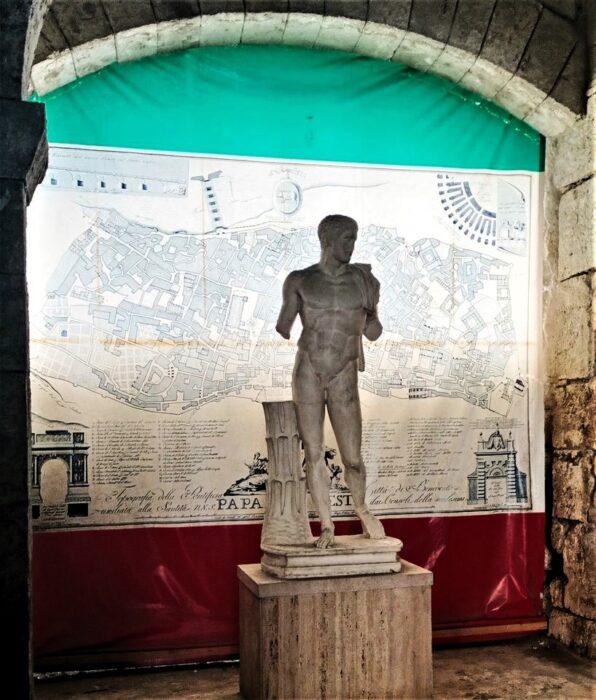Benevento is an important overland stop mentioned by Procopius of Caesarea, even though it isn’t included in Aeneas’ Virgilian itinerary. The Byzantine historian, while narrating the occupation of Samnium by Belisarius in the second year of the Gothic War (535-553), describes Benevento as the place where Aeneas and Diomedes met in order to return the Palladium:
“… This city was built of old by Diomedes, the son of Tydeus, when after the capture of Troy he was repulsed from Argos. And he left to the city as a token the tusks of the Calydonian boar, which his uncle Meleager had received as a prize of the hunt, and they are there even up to my time, a noteworthy sight and well worth seeing, measuring not less than three spans around and having the form of a crescent. There, too, they say that Diomedes met Aeneas, the son of Anchises, when he was coming from Ilium, and in obedience to the oracle gave him the statue of Athena which he had seized as plunder in company with Odysseus, when the two went into Troy as spies before the city was captured by the Greeks. For they tell the story that when he fell sick at a later time, and made enquiry concerning the disease, the oracle responded that he would never be freed from his malady unless he should give this statue to a man of Troy” (Procopius of Caesarea, History of the wars, volume 3, chapter XV, London: Heinemann, 1914)
As Marina R. Torrelli attests in “Benevento romana” (L’Erma, 2002): “Only the Byzantine historian registers a piece of news which is not documented in any of the sources available to us but, as he states, was still relevant during those years, according to which Aeneas and Diomedes’ encounter to return the Palladium happened in Benevento. Here the simulacrum, stolen by Ulysses and Diomedes at the time of Troy’s fall, was given to the future founder of Rome by the Argive hero. Diomedes, who was suffering from a serious illness, was allegedly encouraged to make such a gesture by the response of an oracle which promised him he would heal only if he gave the effigy of the goddess to a Troyan”.
Procopius was able to put in relation Diomedes’ saga with the stories linked to the foundation of Rome and with the myth of Aeneas, promoting Benevento as a place that stands as a symbol of a culture based on hospitality and peace.
With Benevento joining the project, occurred with the resolution of the City Council on the 10 of July 2020, it was headed out the phase of enlargement of the land routes network linked to the project Aeneas Route and to the stages of the journey of Trojan ships described in the Aeneid. The Samnite Capital, which boasts of a big and ancient historic tradition of the Campanian Apennines, reconnects with the coastal site of Cumae.
Diomedes with the Palladium in his hand was the subject of a statue by Kresila, made around 440-430 B.C, of which we have some copies: one of these is preserved in Munich and the other, probably realized by a copyist of the Hadrianic age, was found in the Sybil’s Cave of Cumae.
The Beneventan statue of Diomedes, relegated to the entrance hall of Rocca dei Rettori, is the copy of the one in marble that comes from Cumae, with the broken left arm that certainly had to support the Palladium, kept at the MANN Museum of Naples.
The Aeneas Route Association officially asked for the inclusion of the Diomedes statue in the new route to visit the Museum of Sannio, together with the indication of the European route.
(Anna Maria Mollica)

